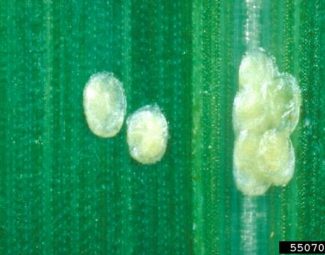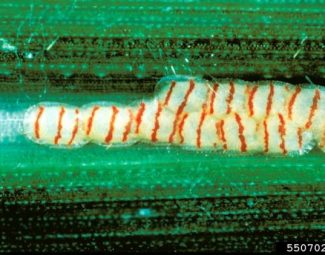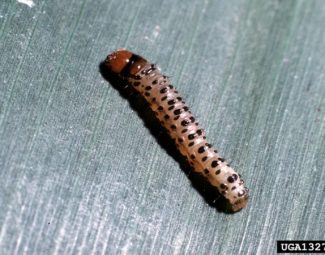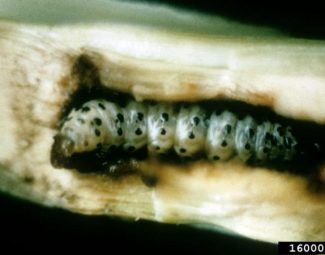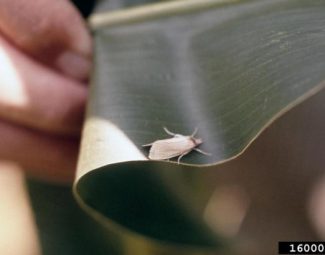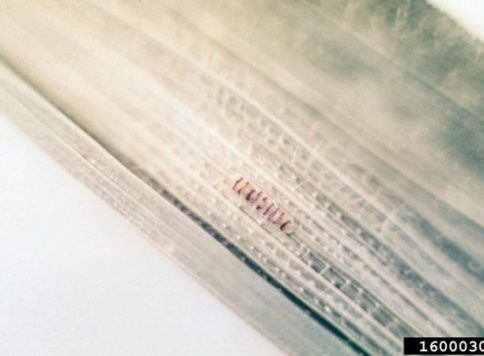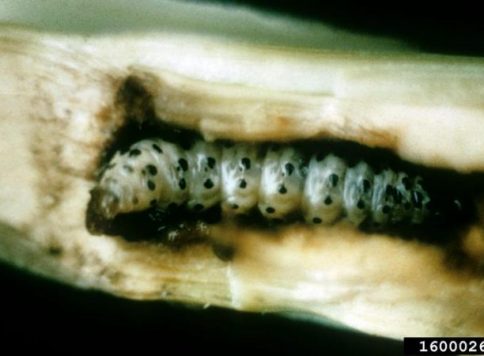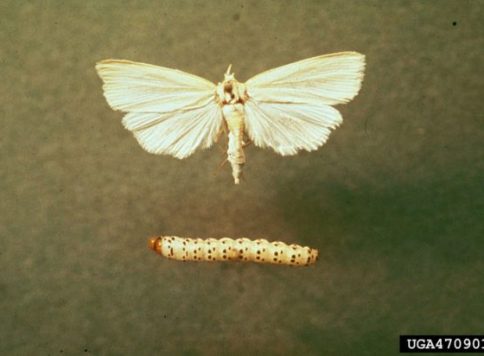Southwestern Corn Borer
Insect Summary Report
Diatraea grandiosella
General Information
- Relatively few host plants. Hosts include: corn, milo, maize, and sorghum. Preferred host is corn (Zea mays).
- Weed hosts include Johnsongrass and various other wild grasses.
- Larva tunnel into stems of host plants. 1st generation larva bore into whorl. Feeding in whorl can cause stunting or destruction of the plant that is referred to as dead-heart injury. Tunneling by later generations decrease ear production and weaken stalks. Diapausing larvae bore into the stalk crown and often weaken the host plant stalk to the point of collapse. Infestations can also cause higher water content (lower dry weight).
- Use sex pheromone for mating recognition. Identified as a combination of (Z)9-hexadecenal, (Z)11-hexadecenal, and (Z)13-octadecenal.
Life Cycle (38-60 Days)
- Eggs… (5-8 Days) 1/8 in. Laid on both the upper and lower surfaces of leaves and on the stalk. Intermediate sized stalks are preferred for oviposition. Flat and elliptical in shape. Can be found singly or in shingle-like groups of 2-5. Yellow, but develop three characteristic orange bands after approx. 36 hours that is referred to as the red bar stage.
- Larva… (28-42 Days) Cream colored with black dots and red or brown head. Diapausing larvae do not display black dots and are light yellow in color.
- Pupa… (5-10 Days) 1 in. Some loose webbing may be found around the pupa, but no cocoon.
- Adult… (Approx. 5 Days) Approx. ¾ in. in length. White. Elongated tent shaped. Nocturnal. Can lay 100-400 eggs in lifetime.
Over-wintering Strategy
Larvae migrate to the base of the stalk below ground level. They then hollow out the interior of the stalk just above the ground, often weakening it to the point of collapse. Typically, only one over-wintering larva per plant. Day length and temperature seem to be determining factors in onset of diapause.
Sampling
- Moths can be sampled with traps baited with synthetic pheromone or blacklight. Trap catches can be used to indicate need for visual sampling for presence of eggs and larval damage. The whorl should be inspected prior to tassel for presence of larva. “Shotholes” and “windowpanes” in leaves can indicate earlier whorl-stage feeding. “Sawdust” excrement around feeding sites may be seen.
- Heat unit models may be useful in predicting generational development and emergence.
Organic Control
- General Info
- Several native wasp and fly parasites serve as natural control in most conditions. Trichogramma wasps have been identified as being parasites of the eggs, especially in the third generation, and are commercially available for augmentative release. Various fungal and bacterial pathogens also serve as important natural controls, especially during diapause.
- Naturally occurring predators of eggs and larva include: minute pirate bugs, lacewings, ladybird beetles and various bird species that include the yellow shafted flicker.
- Electric light traps. Adults are drawn to the light.
- Commonly Used Products
- Terramera Neem Oil
- Terramera Karanja Oil
- TerraNeem EC
- Biorepel (Garlic Oil)
- Bt: Agree; Xentari; Dipel; Javelin
- Entrust (Spinosad)
- Neemix 4.5 (Botanical)
- Gemstar (Biological)
- BoteGHA ES (Biological)
Cultural Control
- Maintain good fertility and mineral balance in plants. Identify macro- and micro- nutrient deficiencies by performing plant tissue and soil analysis. Adjust for deficiencies with foliar and soil applied applications of appropriate fertilizers.
- If transplants are used, inspect them before purchase for signs of feeding and egg deposition.
- Destroy vegetative materials and crop residue immediately after harvest by disking or burning. No till fields may experience higher infestations due to lack of post harvest host plant destruction.
- Control or mow weeds that serve as hosts.
- Early spring planting and/or early maturing varieties can encourage early harvest before populations build to economic thresholds and before corn borers reach diapause. Late maturing crops may be subjected to late season populations, and thus and increase probability for girdling.
- When possible, schedule 2-3 months or more when host crops are not available. This is most effective during winter months when environmental conditions are most severe for pest survival.
- Plant varieties less susceptible to corn borer damage.
- Moist, clay soils will yield increased diapausing mortality than sandy soils.
- Establish and maintain balanced biology in the soil to breakdown crop residues left in soil that may shelter diapausing larva. SP-1 and/or Residuce may be used to augment soil’s capacity for organic decomposition.
More Images of the Southwestern Corn Borer
Bibliography
- Images by John C. French Sr., Retired, Universities:Auburn, GA, Clemson and U of MO, Bugwood.org (eggs, red line stage, and adult)
- Images by Phil Sloderbeck, Kansas State University, Bugwood.org (eggs and eggs in red-bar stage)
- Images by Frank Peairs, Colorado State University, Bugwood.org (larvae photos and dorsal-lateral view of adult)
- Image by Alton N. Sparks, Jr., University of Georgia, Bugwood.org (early instar on leaf)
- Image by University of Georgia, University of Georgia, Bugwood.org (multiple life stages)
- Chippendale, Michael G., and Clyde E. Sorenson. Radcliff’s IPM World Textbooks. Biology and Management of Southwestern Corn Borer. May, 1997. (Life Cycle, Preferred host, damage, pheromone, over-wintering, conventional control, lower dry matter content, Trichogramma, yellow shafted flicker, early planting, effect of soil texture, no-till infestation). http://ipmworld.umn.edu/chapters/chippen.htm
- Boyd, Michael L. and Wayne C. Bailey. University of Missouri Extension. Southwest Corn Borer Management in Missouri. May 2001. (Crop and weed hosts, life cycle intervals) http://extension.missouri.edu/xplor/agguides/pests/g07111.htm

